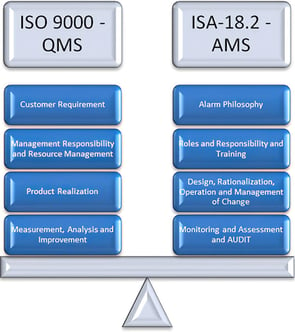This excerpt is from the November/December 2014 issue of InTech magazine and was written by Ram Viswanathan, lead technical specialist at Honeywell Process Solutions in Brisbane, Australia.
Alarm management practices have been in place in the process industries for many decades. With the ongoing developments in the various international standards, such as ANSI/ISA-18.2-2009, and recommended practices such as American Petroleum Institute (API) RP 1167, alarm management has gained greater importance.
The alarm management process life cycle consists of the alarm philosophy, design and implementation, monitoring, managing change, assessment, and the audit for improvement that reflects the familiar continual improvement practices in industries. While alarm performance monitoring measures alarm performance, the periodic audit ensures adequate management and work practices.
The essence of continuous improvement as dictated by the Deming cycle is in the “plan, do, check, and act” (PDCA) processes. The alarm management specification in the process industries can be well aligned with the PDCA cycle, as referenced by the ISO 9000 quality management
principles. The ISO 9001 family of standards provides guidance and tools for companies and organizations to meet customer requirements and to improve the quality of products and services, and the requirements of alarm management standards are no different (figure 1).
By following specific auditing guidelines as per ISA-TR18.2.5-2012 (technical report) and API RP 1167 Section 10, the efficiency and effectiveness of the established system can be reviewed and improved. This article discusses the importance of the audit and the stages when it can be conducted.
Alarm management evolution
From the initial days developing Engineering Equipment and Materials Users Association (EEMUA) guidelines to the development of the ANSI/ISA-18.2 standard, alarm management processes have had a kind of evolution. To improve the evolution cycle, audit and continuous improvement must be the current focus of activity.
User requirements generally guide the evolution of systems, and alarm management is no different. Although the standards have developed from guidelines for annunciation and sequences, the systems have developed from the distributed control system to a more futuristic approach to managing alarms.
Some of the futuristic practical applications of alarm management include advanced mathematical approaches like the fault diagnosis method based on artificial immune systems and dynamic alarm management based on Bayesian estimation. The integration of the two creates mechanisms to dynamically alter the alarm parameters for managing an abnormal situation. The crystal ball for alarm management shows the predictable future of alarm management developing further in data analytics and predictive processing.
Alarm system and alarm system management
The alarm system is a collection of hardware and software that detects an alarm state, communicates that state to the operator, records changes in the alarm state, and monitors the system. Process control systems have built-in alarm systems to perform most of these activities. Additionally, advanced alarm management software complements basic systems with reporting features, alarm management of change process, and intelligent alarming techniques. It is also an external repository for alarms.
But alarm system management is the processes and practices for determining, documenting, designing, operating, monitoring, and maintaining alarm systems. This is guided generally by standards such as ANSI/ISA-18.2, and practices and guidelines from API, NAMUR and others.
The implementation of systems and processes themselves is not sufficient to achieve the alarm objectives; they have to be supported by an effective audit process.
Why audit?
Alarm management is the commitment operating companies make to stakeholders that safety is a critical focus of the operation and that they have the necessary steps to ensure that the mismanagement of the alarms will not be the primary reason for any abnormal situation. The Abnormal Situation Management (ASM) Consortium estimates that operation practices lead to costs of 3–8 percent of plant capacity due to unexpected events, resulting in substantial losses in production across the process industries.
As a result, individual operating sites could define the alarm system benefit as a measure of:
- Reduction in the number of equipment safety incidents
- Reduction in production loss time from improved abnormal situation management
Proper implementation of the alarm system management process has the following direct benefits:
- Effective operator role in managing the process
- Consistent, predictable operator action during abnormal situations
- Systematic approach to resolving process problems from data analysis
- Consistent engineering of the solution through the alarm configuration
The key component of operator effectiveness in the process industries is managing alarms. Hence the implementation of any system or process should directly or indirectly influence the operator to derive total benefit.
Earlier articles referred to achieving alarm management as a journey and highlighted the path to take and the importance of establishing the journey map. Creating an audit process ensures that the path is effective and efficient.
The audit results with the objective evidence of the total benefits should be shared with operators so that they gain confidence in and continue to use the system.
Click here to read Ram Viswanathan's complete article on alarm management at InTech magazine.
About the Author
Ram Viswanathan, lead technical specialist at Honeywell Process Solutions, has been working with different industries for the past 27 years. He is a senior member of ISA and has been working with production operations on the improvement of control room operator effectiveness. Ram also has helped provide input from Australia to IEC TC65/SC65A/WG15 in the development of IEC 62682: Management of alarms for the process industry.





